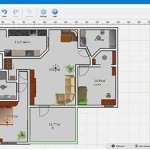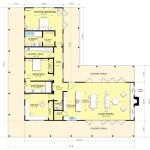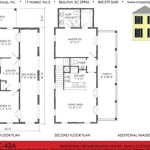In architecture, a floor plan is a blueprint that displays the layout of a building’s rooms and spaces. It typically shows the relationship between rooms, their dimensions, and their organization within the building. Floor plans are essential tools for architects, contractors, and interior designers, as they provide a detailed representation of the building’s design and facilitate decision-making during the construction process.
For small houses, floor plans are particularly crucial in maximizing space and creating a functional and aesthetically pleasing living environment. A well-designed floor plan for a small house can make it feel spacious and inviting despite its limited size. By carefully considering the placement of rooms, windows, and other features, architects can create a sense of flow and openness, making the house appear larger than it actually is.
In the following sections, we will delve into the key considerations for designing floor plans for small houses, exploring different layout options, and discussing the importance of incorporating natural light and creating a seamless transition between indoor and outdoor spaces.
When designing a floor plan for a small house, there are several key considerations to keep in mind to ensure optimal functionality and appeal:
- Maximize natural light
- Create open floor plan
- Use vertical space
- Incorporate storage solutions
- Consider outdoor spaces
- Prioritize flow and circulation
- Choose multi-functional furniture
- Keep it simple and cohesive
By incorporating these elements into your design, you can create a small house that feels spacious, comfortable, and inviting.
Maximize natural light
Natural light can make a small house feel more spacious and inviting. There are several ways to maximize natural light in your floor plan:
Place windows and doors strategically. The best way to let in natural light is to place windows and doors on the south side of your house. This is because the sun rises in the east and sets in the west, so the south side of your house will get the most sunlight throughout the day. If you can’t place windows and doors on the south side, try to place them on the east or west side. Avoid placing windows and doors on the north side of your house, as this is the side that gets the least sunlight.
Use skylights. Skylights are a great way to bring natural light into a room without having to add windows. They can be placed in any room, and they can be especially effective in rooms that don’t have a lot of windows. Skylights can be expensive to install, but they can be worth the investment if you want to maximize natural light in your home.
Use light-colored paint and finishes. Light-colored paint and finishes reflect light, which can make a room feel brighter and more spacious. Avoid using dark colors, as they can absorb light and make a room feel smaller.
Keep your windows clean. Dirty windows can block out natural light, so it’s important to keep them clean. Clean your windows regularly, and be sure to clean the inside and outside of the glass.
Create open floor plan
One of the best ways to make a small house feel larger is to create an open floor plan. An open floor plan is a layout in which the main living areas of the house, such as the living room, dining room, and kitchen, are not separated by walls. This creates a more spacious and inviting atmosphere, and it can also make it easier to move around the house.
- Remove unnecessary walls. The first step to creating an open floor plan is to remove any unnecessary walls. This may involve knocking down walls between the living room and dining room, or between the kitchen and family room. If you’re not sure which walls can be removed, consult with a structural engineer to make sure that the changes you make won’t compromise the integrity of the house.
- Use dividers to create separate spaces. Even if you remove all of the walls in your main living areas, you may still want to create some separation between different spaces. This can be done using furniture, screens, or other dividers. For example, you could use a sofa to divide the living room from the dining room, or you could use a screen to create a separate area for a home office.
- Use multi-functional furniture. Multi-functional furniture can help you save space and create a more open feel in your home. For example, you could use a coffee table that also functions as a storage ottoman, or you could use a sofa bed that can be used for both seating and sleeping.
- Keep your furnishings to a minimum. Too much furniture can make a small space feel cluttered and cramped. Choose furnishings that are essential and that fit the scale of your space. Avoid using large, bulky pieces of furniture, and opt for smaller, more versatile pieces that can be moved around easily.
By following these tips, you can create an open floor plan that makes your small house feel more spacious and inviting.
Use vertical space
One of the best ways to make a small house feel larger is to use vertical space. This means using the height of your walls and ceilings to create more storage and living space. Here are a few ideas for using vertical space in your small house:
Install shelves and cabinets. Shelves and cabinets are a great way to add storage space to your home without taking up valuable floor space. You can install shelves and cabinets in any room, including the kitchen, bathroom, living room, and bedroom. Choose shelves and cabinets that are the right size for your space and that will fit your storage needs.
Use stackable furniture. Stackable furniture is a great way to save space in small homes. Stackable furniture can be used in any room, and it can be especially useful in rooms that are short on space, such as the kitchen or bathroom. Stackable furniture can be stacked vertically to create more storage space or to create additional seating.
Use loft beds. Loft beds are a great way to create more space in a small bedroom. Loft beds are raised beds that are accessed by a ladder. The space under a loft bed can be used for storage, or it can be used to create a separate living space, such as a home office or a play area.
Use curtains and blinds to create height. Curtains and blinds can be used to create the illusion of height in a small room. Hang curtains and blinds high on the walls, and let them flow all the way to the floor. This will make your ceilings appear taller and your room will feel more spacious.
Incorporate storage solutions
One of the biggest challenges of living in a small house is finding enough storage space. However, there are a number of creative ways to incorporate storage solutions into your floor plan without sacrificing style or functionality.
- Use built-in storage. Built-in storage is a great way to maximize space and create a more cohesive look in your home. Built-in storage can be used in any room, and it can be customized to fit your specific needs. For example, you could install built-in shelves in your living room to store books and display items, or you could install built-in cabinets in your kitchen to store pots and pans.
- Use under-utilized spaces. There are a number of under-utilized spaces in most homes that can be used for storage. For example, you could use the space under your bed to store seasonal items, or you could use the space under your stairs to store bulky items like luggage or sporting equipment.
- Use vertical space. Vertical space is often overlooked when it comes to storage. However, there are a number of ways to use vertical space to create more storage in your home. For example, you could install shelves on the walls to store books and other items, or you could use stackable bins to store items in your closets.
- Use multi-purpose furniture. Multi-purpose furniture is a great way to save space and add extra storage to your home. For example, you could use a coffee table with built-in drawers to store blankets and pillows, or you could use a sofa bed to provide both seating and sleeping space.
By incorporating these storage solutions into your floor plan, you can make your small house feel more spacious and organized.
Consider outdoor spaces
When designing a floor plan for a small house, it is important to consider the outdoor spaces as well. Outdoor spaces can extend the living space of your home and provide a place to relax and entertain. Here are a few things to consider when planning your outdoor spaces:
- Create a seamless transition between indoor and outdoor spaces. One of the best ways to make your small house feel larger is to create a seamless transition between indoor and outdoor spaces. This can be done by using large windows and doors that open up to a patio or deck. You can also use similar flooring materials inside and outside to create a cohesive look.
- Use outdoor spaces for multiple purposes. Outdoor spaces can be used for a variety of purposes, such as dining, entertaining, and relaxing. When planning your outdoor spaces, think about how you want to use them and design them accordingly. For example, if you like to entertain, you may want to create a large patio with a built-in grill. If you prefer to relax outdoors, you may want to create a cozy seating area with a fire pit.
- Use vertical space. Vertical space can be used to create more usable space in your outdoor areas. For example, you could install shelves on the walls of your patio to store plants or outdoor gear. You could also use hanging planters to add greenery to your space.
- Don’t forget about privacy. When designing your outdoor spaces, be sure to consider privacy. You may want to install a fence or hedge to create a private space for your family and friends. You could also use curtains or screens to block out unwanted views.
By considering these factors, you can create outdoor spaces that are both functional and stylish, and that will add to the overall enjoyment of your small house.
Prioritize flow and circulation
Flow and circulation refer to the ease with which people and objects can move throughout a space. In a small house, it is important to prioritize flow and circulation to make the most of the available space and to create a comfortable and functional living environment.
- Create a clear path of travel. The main path of travel through your house should be clear and unobstructed. This means avoiding placing furniture or other obstacles in the way. You should also make sure that there is enough space for people to move around comfortably.
- Use furniture to define spaces. Furniture can be used to define different spaces within a small house. For example, a sofa can be used to create a separate living area, and a bookshelf can be used to create a separate reading nook. However, it is important to avoid using too much furniture, as this can make the space feel cluttered and cramped.
- Use multi-functional furniture. Multi-functional furniture can help you save space and create a more flexible living environment. For example, a coffee table with built-in storage can be used to store blankets and pillows, and a sofa bed can be used to provide both seating and sleeping space.
- Keep your belongings organized. Clutter can make a small space feel even smaller. To avoid clutter, it is important to keep your belongings organized. This means putting things away when you are finished with them and finding a place for everything.
By following these tips, you can prioritize flow and circulation in your small house and create a more comfortable and functional living environment.
Choose multi-functional furniture
Multi-functional furniture is a great way to save space and create a more flexible living environment in a small house. Multi-functional furniture can be used for multiple purposes, which can help you to reduce the amount of furniture you need and to make the most of the space you have.
There are many different types of multi-functional furniture available, such as:
- Sofa beds: Sofa beds can be used for both seating and sleeping, which can be a great space-saving solution for small homes. Sofa beds are available in a variety of styles and sizes, so you can find one that fits your needs and your dcor.
- Coffee tables with storage: Coffee tables with storage can be used to store blankets, pillows, and other items, which can help to keep your living room tidy and organized. Coffee tables with storage are available in a variety of styles and materials, so you can find one that matches your dcor and your storage needs.
- Ottoman with storage: Ottomans with storage can be used for both seating and storage, which can be a great way to save space in a small living room or bedroom. Ottomans with storage are available in a variety of styles and materials, so you can find one that matches your dcor and your storage needs.
- Headboards with storage: Headboards with storage can be used to store books, magazines, and other items, which can help to keep your bedroom tidy and organized. Headboards with storage are available in a variety of styles and materials, so you can find one that matches your dcor and your storage needs.
When choosing multi-functional furniture, it is important to consider the following factors:
- The size of the furniture: Make sure that the furniture is the right size for your space. You don’t want to choose furniture that is too large or too small for your room.
- The style of the furniture: Choose furniture that matches the style of your dcor. You don’t want to choose furniture that looks out of place in your home.
- The functionality of the furniture: Make sure that the furniture is functional for your needs. You want to choose furniture that can be used for multiple purposes.
By following these tips, you can choose multi-functional furniture that will help you to save space and create a more flexible living environment in your small house.
Keep it simple and cohesive
When designing a floor plan for a small house, it is important to keep the design simple and cohesive. This means avoiding unnecessary details and clutter, and choosing a consistent style throughout the house. A simple and cohesive design will make your small house feel more spacious and inviting.
Here are a few tips for keeping your floor plan simple and cohesive:
- Use a neutral color palette. Neutral colors, such as white, cream, and gray, can make a small space feel larger and more airy. Avoid using too many dark colors, as they can make a space feel smaller and more cramped.
- Choose furniture that is simple and functional. Avoid furniture with too many ornate details or embellishments. Instead, choose furniture that is simple and functional, and that fits well with the overall style of your home.
- Use similar materials throughout the house. Using similar materials throughout the house will create a cohesive look and feel. For example, you could use the same type of flooring in all of the rooms, or you could use the same type of countertops in the kitchen and bathrooms.
- Don’t overcrowd your space. Too much furniture and clutter can make a small space feel even smaller. Instead, choose a few pieces of furniture that you love and that fit well in the space. Leave some open space around your furniture so that you can move around comfortably.
By following these tips, you can create a simple and cohesive floor plan that will make your small house feel more spacious and inviting.










Related Posts








